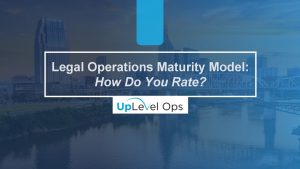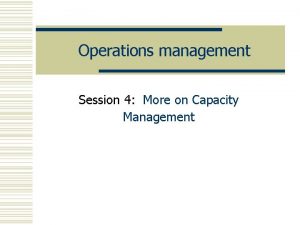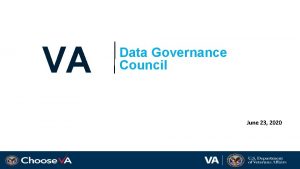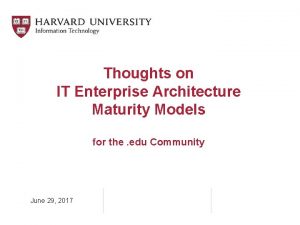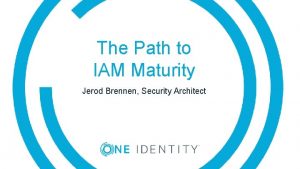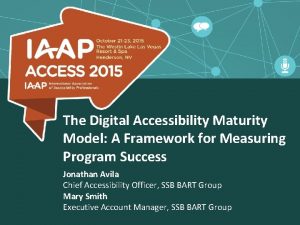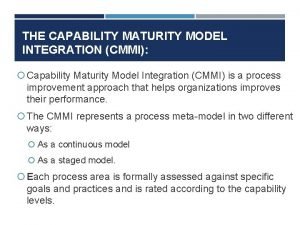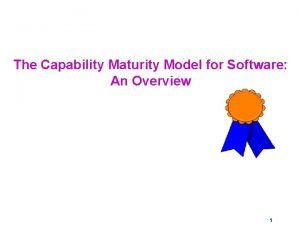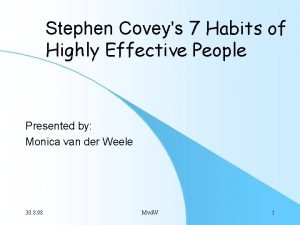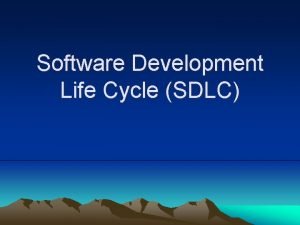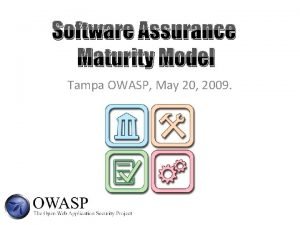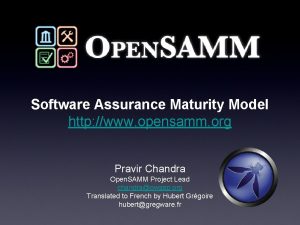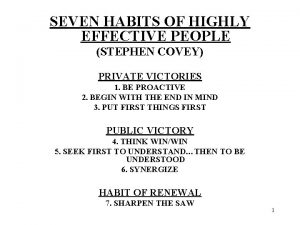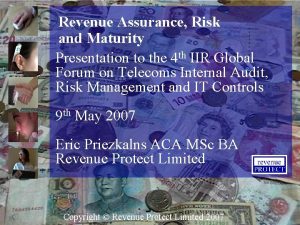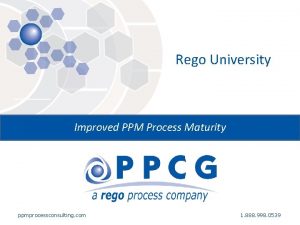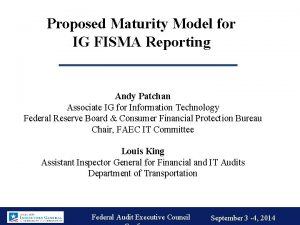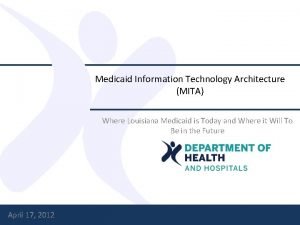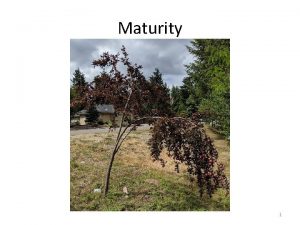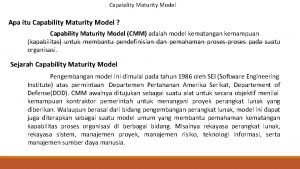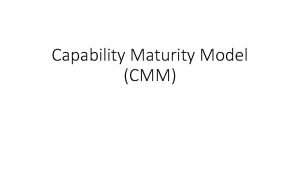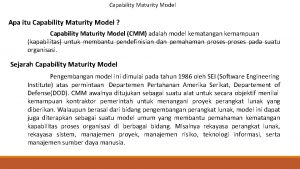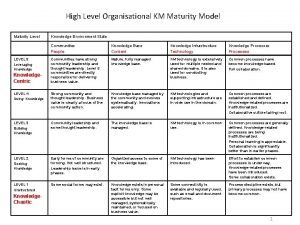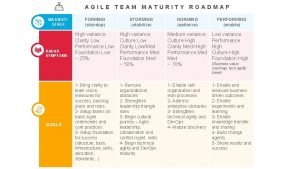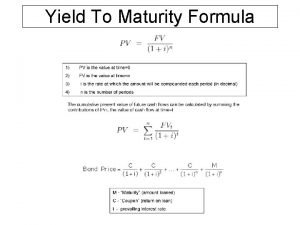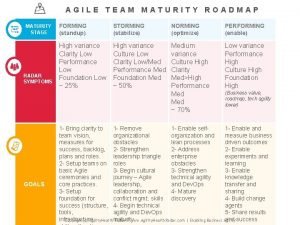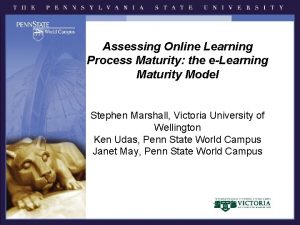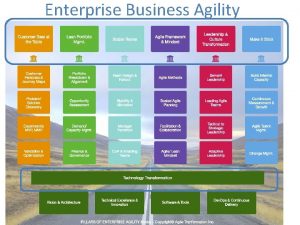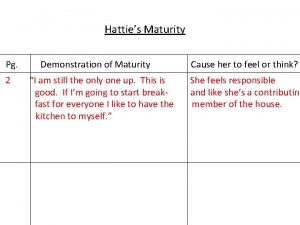Legal Operations Maturity Model How Do You Rate





















- Slides: 21

Legal Operations Maturity Model: How Do You Rate?

Legal Operations Core Competencies Priorities Recoveries Initiatives Strategic Planning Financial Mgmt. Legal & Compliance Risk Mgmt. Culture & Org. Developme nt Change the colors of the fills of the gray competencies to red, yellow or green to reflect the priority you assign to that capability OC / Vendor Mgmt. Contract Mgmt. Legal Operatio ns Function Strategic Coverage Model HR Processes Global Info Governance / Records Mgmt. Data Analytics & Metrics Medium Legal Tech Roadmap & Portfolio Mgmt. ASP Manageme nt Litigation Support Cross. Functional Alignment Process Support Low High Knowledge Mgmt. 2

Strategic Planning Place the light blue ball where you self assess your maturity in this competency to be today & the dark blue ball where you would like to be in the future • Create a long-term strategy, aligning yearly goals & corresponding metrics. Under Developed • No time for strategic planning; fire fighting mode • No formal goals set or documented for department beyond annual budgets; everyone just “keeps their heads down” Developing • Annual goals set for operations function • Some level of strategic planning performed & metrics considered Efficient • Annual goals set; metrics identified & tracked over time • Alignment with broader law department & corporate goals in fully documented strategic plan • Plan is visible within law department & accountability is shared Best In Class • Metrics-driven multi-year plan in place • Full awareness of plan with quarterly reviews relative to goals, including key business clients • Planning includes elements of strategy, structure, change management, & culture • Plan is tied to team member performance objectives & has impact on compensation Self Assess Today Future Desire 3

Financial Management Place the light blue ball where you self assess your maturity in this competency to be today & the dark blue ball where you would like to be in the future • Manage the departmental budget. Track accruals & forecasting. Work with Finance to identify spending trends, potential cost savings & efficiency opportunities. Under Developed Developing Efficient Best In Class • Undefined & ad-hoc • Focus on external spend management • Focus on internal & external spend • Focus on total cost internal, external, settlements, headcount) Budgeting & Forecasting • Non-standardized criteria for when budgets & forecasts need to be set • Criteria set for which matters require budgets & forecasts • Standard process, frequency & dedicated team for external spend • Fully comprehensive internal & external budgets & forecasts • Centralized spreadsheets Technology • Individually managed spreadsheets & decentralized tracking • External spend budgets managed within MM tools • Centralized dashboard & targets for internal & external spend mgmt • Undefined metrics & lack of access • Defined metrics but difficult to gain access • Defined metrics & frequent access, but manually generated • Defined metrics, frequent access & automated dashboard-driven • Reactive analysis & fire extinguishing • Consistent frequency & scope of macro-analysis • Consistent frequency & scope of micro-analysis • Automated scorecards & alerts (traffic lights) Scope Visibility & Tracking Identifying Opportunities Self Assess Today Future Desire 4

Outside Counsel / Vendor Mgmt. Place the light blue ball where you self assess your maturity in this competency to be today & the dark blue ball where you would like to be in the future • Create a partner management program to ensure quality outside counsel & vendor support at the right rates & under optimal fee arrangements. Hold regular business reviews. Negotiate fee agreements. Drive governance of billing guidelines. Under Developed Developing Efficient Best In Class Number of Firms/Vendors Retained • Many firms used; highly distributed spending • Fewer major firms; perhaps 70 -30 split • Consolidation & concentration; firms matched with the nature of the work • Consolidated to core teams that know your business very well at few law firms Retention Practices • Unstated criteria for retention; siloed decision making • Guidelines, approved counsel list • Periodic RFPs & competitive bidding • Preferred Provider Program, historical data used to driven selection process Fee Arrangements & Invoice Review • Hourly billing with some discounts • Invoices reviewed manually without e-billing • Extensive use of discounts, plus some fixed fees & incentives • Invoice reviewed online by internal team • Non hourly arrangements consistently considered • First pass invoice review done by finance team; attorney review time reduced • Well-defined, data-driven process to identify AFA opportunities & measure their success • Invoice review optimized through use of dedicated teams Rate Review Process • No standardization or centralization; no benchmark data; rates at TK level • Defined timeline, but allow • No exceptions to defined exceptions; no tools; some timeline, centralized review benchmarks team; tools used • Centralized team utilizing automated tools to negotiate using benchmarks/analytics • No consistent process for communicating feedback • Sporadic meetings with vendors to discuss goals & feedback • Consistent sharing of vendor scorecards, meetings to conducts after action reviews; aligned with CLOC guidelines Performance Management • Defined process & cadence to provide feedback & lessons learned Self Assess Today Future Desire 5

Contract Management Place the light blue ball where you self assess your maturity in this competency to be today & the dark blue ball where you would like to be in the future • Support best-in-class process for contract coverage, resourcing, spend & technology. Under Developed Legal Coverage Resourcing Strategy Technology Efficient Best In Class • Inconsistent legal responsibilities for contracts lifecycle • Legal partners with business & supporting functions to develop clear governance, contract lifecycle processes, & risk standards • Optimization of contract lifecycle with business teams • Clear understanding of contract risks & consistent application of tools, processes & standards • Focus on value creation through contract analytics, obligation management programmes • Varies with lawyers, business & contract specialists playing different roles • Procurement not integrated with legal • Specialist contract teams in major areas • Use of paralegals/ contract negotiators/ alternative providers for contract admin • Clear bifurcation of tasks to appropriate level of internal legal resource • Increasing use of paralegals/ contract negotiators/ alternative providers for contract admin • Business self serve where appropriate, legal manages exceptions/ bespoke agreements • Extensive use of paralegals/ contract negotiators/ alternative providers for contract admin • None • Basic KPIs established & measured • Spend with outside providers tracked • Sophisticated KPIs established & measured • Total Cost of Ownership measured • Culture of continuous improvement – goal setting, management decisions about resourcing, • Lawyers use personal library of contracts • Consolidated contract library • Company-wide clause banks/ positions agreed • Playbooks, approval matrixes & process maps for main contract types • Culture of continuous improvement – goal setting, management decisions about practices • Driven by spreadsheets, word processing tools, i. e. email & MS Office • Central contract repositories • Contract generation tools in place • Limited self-service tools • End to end CLM tools fully embedded to facilitate workflow, escalations & data capture • Use of e. Signature • Extensive self-service tools • Machine learning capabilities to drive improvements • Robust KM system linking all members of ecosystem Metrics & Cost Operations & Infrastructure Developing Self Assess Today Future Desire 6

Data Analytics & Metrics Place the light blue ball where you self assess your maturity in this competency to be today & the dark blue ball where you would like to be in the future • Collect & analyze relevant data from department tools & industry sources, define objectives to provide metrics & dashboards, that drive efficiencies & optimize spend, etc. Under Developed Analysis of Departmental Data & Metrics • Undefined scope of metrics &/or performance measures Developing • Defined set of metrics & performance measures Efficient • Quarterly generation & review of departmental metrics Best In Class • Automated & real-time visibility into key metrics / variance; aligned with CLOC guidelines • No access to industry data • Access into general departmental surveys • Access into peer aligned departmental surveys • Access into area-specific analytics & benchmarking (spend, contracts, IP, e-discovery, etc. ) Dynamic Dashboards • Ad-hoc & de-centralized reporting from legal applications • Robust dashboards for a single legal application (likely MM/e-Billing first) • Robust dashboards for each legal application • Automated & centralized single-point of reporting across the department Data-Driven Decision Making • Re-active request & analysis of information relevant to the work • Established knowledge bank or data with manual search • Established analytics platform boasting relevant metrics • Integrated data recommendations based on work at hand Analysis of Industry Data & Metrics Self Assess Today Future Desire 7

Legal Tech Roadmap & Portfolio Mgmt. • Manage your current technology & have a vision for where it will take you in the future Place the light blue ball where you self assess your maturity in this competency to be today & the dark blue ball where you would like to be in the future Under Developed Developing Efficient Best In Class • LD cannot identify what technology gaps exist or how they should be prioritized • Not familiar with categories of available tools or the options within them • Technology selections based on advice of salespeople, brand recognition, or because it is what “everybody else” is using. Tools not purchased strategically, but purchased in desperation, when pain has become unbearable. • No time/attention/skill available to negotiate good deals with vendors • Tool buildouts are poorly envisioned, poorly implemented, & lead to suboptimal adoption • Too many tools & not enough value generated • Little or no integration between tools • No vision for the future or plan of how to get there. • LD knows some of its biggest pain points, but has difficulty deciding how to prioritize them & may do nothing • Has superficial knowledge of the most common tools in the most common spaces • Technology selections made deliberately, after studying the issue & talking to colleagues from other organizations • Some attempt to negotiate pricing & other terms with vendors, but vendors are far more sophisticated • Tool buildouts are given some thought, implementation is at least passively monitored, & is good enough to facilitate adoption • An awareness of tool proliferation issues, but difficulty avoiding their occurrence • Integrations between tools when it makes sense, but trouble maintaining them • Many people have a decent gut feeling of where the LD wants to be with technology in the future, but others are in the dark or cannot agree on a plan • LD knows some of its biggest pain points, but has difficulty deciding how to prioritize them & is somewhat slow to address them • Good understanding of the legal tech marketplace & common tools in all the major spaces • Fairly systematic approach to one-off technology procurement decisions, including institutional knowledge of prices for different products • Demonstrated ability to negotiate down prices or obtain other benefits in negotiations with vendors • LD is able to articulate desires prior to design & implementation & is experienced at managing implementation projects & making sure it gets what was bargained for • Demonstrated ability to keep the number of tools manageable • Appropriately chosen & maintained integrations between tools • An above-average vision of where tech needs to take you that is communicated to & supported by stakeholders • LD knows exactly where its pain points are, how technology can solve them, & how to prioritize solutions • Keen knowledge of legal technology marketplace, including new developments & tools in adjacent markets • Sophisticated, repeatable technology procurement processes • Technology selection based on independent research & rational self-interest, not the assertions of vendors or blind imitation of other law departments • LD has significant expertise in negotiating pricing, design, implementation, & service terms with vendors • LD has excellent relationships with vendors, partners with vendors to co-create new product features, & gets preferential treatment over other customers • Tool buildouts are properly designed & implemented to maximize adoption & value-creation • LD avoids tool proliferation & builds & maintains integrations when appropriate • A clear, agreed-upon vision of where tech needs to take you in the next 1, 3, & 5 years Self Assess Today Future Desire 8

Alternative Support Provider (ASP) Mgmt. • Drive departmental efficiency by leveraging the right resources for the right matters, including using managed services, LPOs, and other service providers and technology as appropriate. Place the light blue ball where you self assess your maturity in this competency to be today & the dark blue ball where you would like to be in the future Under Developed Developing Efficient Best In Class • LD cannot identify what areas would be the best fit for ALSP’s rather than law firms – use of ALSP’s is haphazard at best • Intimidated by the idea of dealing with ALSP’s– not familiar with what they do or how they work • No time/attention/skill available to negotiate good deals with ALSP’s • Service buildouts are poorly envisioned, poorly implemented and lead to suboptimal results • No vision of the future or plan of how to get there • LD knows some of its biggest pain points ALSP’s could fill, but has difficulty deciding how to prioritize them & may do nothing • Has superficial knowledge of the most common ALSP’s in the most common spaces • ALSP selections made deliberately, after studying the issue & talking to colleagues from other organizations • Some attempt to negotiate pricing & other terms with vendors, but vendors are far more sophisticated • Service buildouts are given some thought, implementation is at least passively monitored • Many people have a decent gut feeling of where the LD wants to be with ALSP’s in the future, but others are in the dark or cannot agree on a plan • LD knows some of its biggest pain points ALSP’s could fill, and is competent about prioritizing them and making it happen • Good understanding of the ALSP marketplace and services available • Strong knowledge of prices for different services • Demonstrated ability to negotiate down prices or obtain other benefits in negotiations with vendors • LD is able to articulate desires prior to design & implementation & is experienced at managing implementation projects & making sure it gets what was bargained for • An above-average vision of where ALSP’s need to take you that is communicated to & supported by stakeholders • LD knows exactly where its pain points are, how ALSP’s can solve them, & how to prioritize solutions • Keen knowledge of ALSP marketplace, including new developments & how technology fits in • ALSP selection based on independent research & rational self-interest, not the assertions of vendors or blind imitation of other law departments • LD has significant expertise in negotiating pricing, design, implementation, & service terms with vendors • LD has excellent relationships with vendors and partners with vendors to co-create new ways of working together. Gets preferential treatment over other customers • Service buildouts are properly designed & implemented to maximize value-creation • A clear, agreed-upon vision of where ALSP’s need to take you in the next 1, 3, & 5 years Self Assess Today Future Desire 9

Knowledge Management Place the light blue ball where you self assess your maturity in this competency to be today & the dark blue ball where you would like to be in the future • Enable efficiencies by creating seamless access to legal & department institutional knowledge through the organization & centralization of key templates, policies, processes, memos, & other learnings. Under Developed People Processes Technology • No resources with KM included in responsibilities • No formal process to capture & reuse knowledge • Driven by spreadsheets & word processing tools, i. e. email & MS Office Developing Efficient Best In Class • Portion of someone’s role includes KM expectations • Dedicated resource to drive KM culture • Dedicated team driving KM best practices & actively publicizing lessons learned • Basic expectations communication around use of KM tools • Clearly defined & documented expectations for work product reuse • Consistent communication around new content • Active process to identify, capture, & publicize best practice materials & content • KM update is agenda point in all key items for proactive KM • End to end tools fully embedded to facilitate workflow, escalations & data capture; Extensive selfservice tools • Machine learning & AI capabilities to drive further efficiency & improvements w/ robust workflow & KM system linking all members of ecosystem • Central open access knowledge repositories with limited self service or categories Self Assess Today Future Desire 10

Process Support Place the light blue ball where you self assess your maturity in this competency to be today & the dark blue ball where you would like to be in the future • Create a long-term technology roadmap including leading tools & drive high levels of data quality & user adoption. Under Developed Technology Roadmap • Non existent Caliber/Scope of Tools • MS Office & email • Second tier legal products no longer/not considered market leaders Developing Efficient Best In Class • 5 year strategic map with how tech will support objectives with planned effort, costs, convergence & integrations • Business objectives defined & key preferred techs identified • 3 year plan broken into horizons with effort costs • + MM/e. Billing; Share. Point; e. Signature; Document Mgmt • Most tools are considered among market leaders • + Integrated MM/Claims; Legal Hold; IP Mgmt; Contract Mgmt; Knowledge Mgmt; GRC • Tools are market leaders • + Dashboards/analytics; EDD; Intake/Workflow/Self Service; Legal Project Management • All tools are market leaders Quality of Data • De-centralized & non standardized tracking of info. • Much of it lies in email or unstructured forms • Defined, but limited, standard tracking elements • Limited compliance & completeness; • Rule-based validation of standard information tracking • Complete within systems, but not across systems • Standard core data across systems • Aligned with legal department reporting metrics • Complete, synched & clear primary sources of records (no issue of redundant data) Level of User Adoption • Most tools only used by support staff • Attorneys using core tools for basic tasks, but opt out of significant usage • All levels are using core set of tools • All level are using tools, leveraging analytics, & represented in tech steering committee Self Assess Today Future Desire 11

Cross-Functional Alignment Place the light blue ball where you self assess your maturity in this competency to be today & the dark blue ball where you would like to be in the future • Create & drive relationships with other key company functions, such as HR, IT, Finance & Workplace Resources. Represent the Legal organization in industry groups. Under Developed Influence Extent of the Relationship Developing Efficient Best In Class • None or limited • Interactions are on an “as needed” basis with no real alignment • Basic relationships w Finance & IT support very basic dept needs • HR relationships address issues real time but w/o any favors • Basic alignment • Strong relationships support day-to-day operations, especially in IT, Finance & HR • Support from partner is reactive rather than proactive • Able to leverage partners to drive legal dept strategy • Other functions come to legal ops with information in advance of “activities” • Receive special favors • Partners help drive strategy • None or limited • No real understanding of the value of internal ties to other key functions. • Has some understanding of the need • No dedicated legal team contact or ad hoc/rotational assignments not including legal ops • Legal Ops owns the relationships & has developed them at a basic level • Meets regularly with Finance & has solid relationships with IT & HR • Has basic ties to key Exec Staff EAs • Legal ops leader has deep relationships with all x-functional teams, esp. finance, IT, HR, & security, comms, & other HQ & client group leads & Exec Staff EAs • Legal ops x-functional connections serve as an early warning system Self Assess Today Future Desire 12

Place the light blue ball where you self assess your maturity in this competency to be today & the dark blue ball where you would like to be in the future Litigation Support • Support e-discovery, legal hold, document review & drive optimal cost structure for this work. Under Developed Coverage Developing Efficient Best In Class • Reactive teams managing litigation • Legal support to business to establish compliance frameworks • Proactive post-Litigation reviews to improve operational risk mgmt. • Mature use of litigation alternatives • Advocacy to shape external agenda • Legal have proactive role in Information governance agenda • Default to use of law firms • In-house team grown to provide proactive litigation mgmt. & oversight of law firm’s use of vendors/staffing; • Established role for Lit/EDD PM • Use of law firms aligned to litigation risk • Send all e-Discovery to internal/specialist providers • Full use of alternative providers for non-advisory (EDD, med legal, court reporting) • External counsel integrated with each other & in-house team • Law firm driven scoping & rate setting • In-house driven scoping of litigation strategy • Demand firms present alternative pricing or solutions • Use of AFAs for major litigation; Formal budgeting; consistent invoice review; Billing rules drive KM across entire legal ecosystem • Analytics support instruction decisions & law firm staffing models • No central KM platform or reporting or processes • Core litigation reporting established • Data retention, legal hold, & data destruction policies • Playbooks established for different litigation types; Formal tools for budgeting; Central repository of briefs, pleadings & research • End to end legal project mgmt. method defined & used • Legal holds managed via email & MS Office • e-Discovery & legal hold platforms in place • Experimentation with machine learning; Legal project mgmt. tools used internally • AI/machine learning e-Discovery tools widely used • LPM tools mandated externally Resourcing Cost Control Operations & Infrastructure Technology Self Assess Today Future Desire 13

Global Info Governance / Records Mgmt. Place the light blue ball where you self assess your maturity in this competency to be today & the dark blue ball where you would like to be in the future • Create a holistic information governance & records management program including a record retention schedule, policies & processes addressing data privacy, info classification, etc. Under Developed People Processes Technology Developing Efficient Best In Class • Records Management resources focused on file room maintenance • No information governance resources • Someone has responsibility for Information Governance but not a formal title • Information Governance lead with visibility across law department & company • No defined records processes outside of Retention Schedule • Data governance processes defined but no accountability for implementation • Processes defined & implemented • Monitoring for compliance • Thorough data classification, governance, & disposition process • Fully enforced through technology & management oversight • Basic file management system in place • Automated enforcement of retention schedule • Advanced tools for both records retention & email archiving • Leading edge technology for information governance & records retention; integrated with all relevant legal systems for automated disposition • Records & Information Governance team with senior representation in law department & across company Self Assess Today Future Desire 14

HR Processes • Acquire talented, motivated people & help them become even more talented & motivated Under Developed HR Strategy Leadership Development Talent Pipeline Departmental Culture Training & Development Developing • Org. employs HR tactics but has no overarching HR strategy • HR activity is mostly putting out fires • Leaders have a weak bond with teams, teams have a poor understanding of what to do & act mostly to avoid punishment & get rewards • Weak pipeline – org. has no reputation or bad reputation & people do not want to work there • Org. relies on job posting sites, recruiters, & other non-organic means of talent acquisition • • “Every man for himself” culture— employees are uninspired & just there to get a paycheck • High turnover • Higher likelihood of unethical behavior • Former employees badmouth the org. after leaving • • Training is perfunctory • Little opportunity for advancement • Promotions are not perceived as fair • • Efficient • Org. has a written HR strategy that employees know & understand, but it is not always executed well. • Departmental HR metrics tracked & reported but numbers not improving • HR function is ancillary or siloed—an afterthought • Org. has a written HR strategy that all workers are familiar with & cooperate in furthering. • Strategy tends to focus on protecting the short- to mid-term interests of Legal rather than the long view or needs of broader org • Departmental HR metrics tracked & reported & numbers show steady improvement • Leaders are developing stronger bonds with teams, teams are developing understanding of what to do & do it willingly • Leaders have strong bond with teams, teams understand what to do & are eager to do it Developing pipeline – org. building reputation for being a good place to work Org. is developing relationships with schools, industry groups, & other organic sources of talent acquisition • Strong pipeline – people have heard of the org. & want to work there • Candidates hear about employment opportunities organically through schools, industry groups, etc. • Cost & time to acquire talent goes down as more & more high-quality candidates seek out the org. proactively Culture of “me” – employees try hard but still act mainly to help themselves Turnover & unethical behavior are still real concerns • “Team” culture – employees work hard to understand one another & make sacrifices for the greater good • Morale is high & motives are mostly pure • Legal teams adapt processes to deliver value to other departments rather than just worrying about CYA Fair & logical system for training & promoting workers Training perceived as boring or irrelevant & little variety in the kinds of promotions available • Fair & logical system for training & promoting workers • Training is perceived as interesting & relevant • Creates ways for workers to grow along different paths, according to their skills & interests Place the light blue ball where you self assess your maturity in this competency to be today & the dark blue ball where you would like to be in the future Best In Class • • Mature HR strategy tailored to reflect the needs to the larger business, not just the LD Strategy reflects not only current business needs but anticipates needs over the next 5 -10 years HR is fully integrated into the LD overall business strategy Departmental HR metrics outperform similar orgs • Leaders inspire others to constantly grow both in & out of work • Teams anticipate organizational needs & proactively address them without being asked • Very strong pipeline—very strong candidates proactively network with the org. & develop relationships with it even when no openings are available • Cost & time to acquire are greatly reduced. • • “Inspired” culture—LD culturally integrated with others, business partners, community orgs Barriers & defensive behavior minimized; stakeholders can have real conversations Even after leaving the org. , former employees continue to promote it Employees feel like they are constantly growing • Workers are empowered to develop their own career paths by pursuing different interests & identifying & working with new groups of people inside & outside the org. in fluid ways that defy traditional linear, hierarchical career patterns 15 Self Assess Today Future Desire

Strategic Coverage Model Place the light blue ball where you self assess your maturity in this competency to be today & the dark blue ball where you would like to be in the future • Drive departmental efficiency by appropriately matching the nature & risk of the work with the right level & type of resources; be that internal, outside counsel, or managed services, LPOs, & other service providers. Under Developed Demand Management Coverage Resource Allocation Use of Alternative Service Providers • Direct business stakeholder to legal interaction Developing • Share. Point accessible matrix to assist “who to call” for what Efficient • Intake workflow or legal front gate to triage work to appropriate party Best In Class Self Assess Today • Automated workflow & intake, including self-service & autoassignment based on coverage, type, complexity • Inconsistent legal responsibilities for various types of work • Legal partners with business & supporting functions to develop clear governance, processes, & risk standards • More proactive engagement with the business & alignment based on type & location • Fully collaborative partnership, accessibility & interaction points depending on type/complexity of work • Inhouse teams & overflow to outside counsel • Targeted law firm staffing model & targets for various major areas of work (focus on external resource allocation) • Allocation of tasks to appropriate level of internal resource; consideration of alternative providers; OC used for expertise • Business self serve where appropriate, legal manages exceptions/ bespoke matters’ extensive use of paralegals & ecosystem of alternative providers • Non-existent • Use of secondees for specific individual gaps &/or large low complexity projects • Strategic use of ASPs for litigation &/or e. DD • Centralized & strategic use of ASP powered centers for contracts, due diligence, IP, compliance & legal ops Future Desire 16

Culture & Organizational Development Place the light blue ball where you self assess your maturity in this competency to be today & the dark blue ball where you would like to be in the future • Work collaboratively across the legal ecosystem to create consistent global processes from onboarding, to regular departmental communications, to sophisticated all-hands off-sites. Responsiveness Under Developed Developing Efficient Best In Class • No real connection to the team reflecting a lack of understanding of the need to address critical company or org changes • Action limited mostly to critical events & then only on an ad hoc basis. Limited consideration to messaging • Appreciation of the need & value; Plan mostly based on events rather than part of a strategic plan • Plan in place ahead of events. Key messaged tied to goals, strategy & mission/vision • Immediate ability to respond to critical company or dept events • • • • Weekly Chalk Talks Comprehensive Web Portal Monthly or Qtrly All Hands Annual Legal All Hands Offsite Team fully informed & speak to goals Leverage mentoring Leverages clear succession plans Uses clear consistent feedback Core to dept culture Methods & Cadence • Ad hoc email only • Team feels a lack of clear communication from the GC & GC Staff Regular email Irregular All Hands Meetings Basic web portal Team has some sense of key initiatives Regular email Regular All Hands Comprehensive portal Irregular All Hands Offsites Management Focus on Career Development • Ad hoc. Not seen as a priority • Developing guidelines & used for senior attorney roles; • No appreciation for the power of tools & HR instruments • All levels of legal mgmt leverage tools & participate in dept planning • Part of dept planning • • Organizational Structure • None or Ad Hoc changes made to retain talent. Titles used to lure in talent vs. being standard criteria • Limited use of org structure to create cross-training & other prof dev opps. • Clear focus with some effort to leverage structure • Clear focus with extensive use of matrix & other structures where appropriate Onboarding • No specific effort by the legal team; reliance on company onboarding • Limited & Ad Hoc by Region & Office Location • Standardized across regions with no local • Standardized Global Onboarding Processes specific to legal w regional variations Self Assess Today Future Desire 17

Legal & Compliance Risk Mgmt. Place the light blue ball where you self assess your maturity in this competency to be today & the dark blue ball where you would like to be in the future • By acting diligently & creating complete transparency within your organization or business, you invariably discover & resolve many hidden risks, saving you & your organization from easily avoidable losses. Under Developed Developing Efficient Best In Class • Corp. cannot identify or agree on key regulatory & compliance risks, even informally • Policies & procedures do not exist or are siloed, poorly disseminated, poorly understood, outdated, or not taken seriously • No controls or very weak controls. No testing of controls • No technology to support compliance, or technology is underutilized • Executives do not model desired behavior • Incidents may not be investigated & remediated properly. There is little or nothing done to prevent recurrence • Compliance team may try to minimize all risk, rather than partnering with business people to help them achieve goals with an acceptable level of risk • Corp. has a good idea of where key risks are, but no real data to back up suspicions • Policies are procedures are orderly & made available, but not systematically disseminated & tracked • Some controls &/or testing • Basic compliance technology, like an incident management / case management platform. Probably no GRC platform or GRC platform poorly used • Executives avoid bad behavior but do not necessarily model good behavior • Incidents are investigated & remediated, & there at least conversations about how to avoid recurrence • Risk is viewed as something to be managed, not eliminated or minimized • Corp. knows where key risks are both on a company & industry level & has data to back up conclusions, but cannot necessarily anticipate future risks very well • Policies & procedures are systematically authored, edited, disseminated, & tracked • Controls & testing of procedures in key business units & business processes (e. g. , new product development) • Corp. has significant compliance technology, probably including a GRC platform, although it may not be used to its full potential. Effectiveness of program is tracked & managed • Executives are trained to model & understand the importance of modeling good behavior, & mostly do so • Incidents are systematically investigated, remediated, & may be mapped back to policies, procedures & controls, which are sometimes updated to prevent future incidents • Risk is viewed as something to be managed, not eliminated or minimized • Corp. uses hard data to quantify current risk & anticipate future risk • Policies & procedures are systematically authored, edited, disseminated, tracked, controlled & tested at all appropriate levels, business units & business processes • Corp. has GRC & related technology & fully uses it. Compliance processes are streamlined & all departments can enforce & track them easily • Executives are trained to model exemplary behavior & excel at doing so • Incidents are systematically investigated, remediated, & mapped back to policies, procedures & controls, which are regularly updated to prevent future incidents • When risks are unavoidable, LD collaborates with leaders in other departments to arrive at a consciously chosen tradeoff on a risk/reward continuum Self Assess Today Future Desire 18

Recoveries Initiatives Place the light blue ball where you self assess your maturity in this competency to be today & the dark blue ball where you would like to be in the future • Through careful selection of recovery initiatives, legal departments can bring revenue to the company while maintaining valuable business relationships & avoiding costly litigation. Content Under Developed Developing Efficient Best In Class • Little or no recognition that recoveries could be a legitimate priority • Unaware of most or all recoveries options • LD is not systematic & prudent in choosing which recoveries to pursue • Pursues recoveries in an inappropriate way that destroys key business relationships • Lengthy court battles distract executives from more fundamental business tasks • LD recognizes recoveries as a potential priority • Aware of many recoveries options but does not sift through them systematically • Foregoes many valuable opportunities because it does not know how to pursue them without damaging relationships • LD recognizes recoveries as important & sifts through them informally • Starts to have confidence in its ability to generate recoveries without causing undue damage to relationships • LD views recoveries as a strategic priority & appoints a highly visible “champion” who leads them • Company proactively monitors contractual obligations of business partners & identifies opportunities for recovery • LD is selective & weights risks & rewards of pursing recoveries based on: Likelihood of recovery, possibility of litigation, cost of potential litigation, & effect on business relationships • Recovery efforts actually improve business relationships, except in rare instances when damage is necessary & justified Self Assess Today Future Desire 19

Edit the data in the chart & you will see a picture of your maturity for each competency of where you are today & what you would like to achieve in the future, sorted by decreasing priority. Maturity Survey 0 Under Developed Developing Efficient 1 Best In Class 2 3 Strategic Planning Global Info Governance/ Records Management Litigation Support Culture and Org Design Financial Management Contract Management Outside Counsel/ Vendor Management Technology Support Data Analytics and Metrics Strategic Coverage Model Knowledge Management Cross-Functional Alignment 0 1 2 3 4 Linear(Priority) 20

Thank You!
 Clm maturity continuum
Clm maturity continuum Importance of maturity indices
Importance of maturity indices Utilization rate operations management
Utilization rate operations management Data governance council maturity model
Data governance council maturity model Cmmi
Cmmi Identity and access management capability maturity model
Identity and access management capability maturity model Digital accessibility maturity model
Digital accessibility maturity model Cmmi maturity levels
Cmmi maturity levels Sei cmm full form
Sei cmm full form Covey's 7 habits model
Covey's 7 habits model Cmmi software development life cycle
Cmmi software development life cycle Samm assessment worksheet
Samm assessment worksheet Software assurance maturity model
Software assurance maturity model Nicholas changelo
Nicholas changelo Maturity continuum model by stephen
Maturity continuum model by stephen Revenue assurance maturity model
Revenue assurance maturity model Ppm maturity model
Ppm maturity model Ig maturity model
Ig maturity model Project portfolio process 8 steps
Project portfolio process 8 steps Pcmm training
Pcmm training Omnichannel maturity model
Omnichannel maturity model Mita maturity model
Mita maturity model
